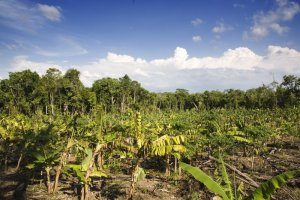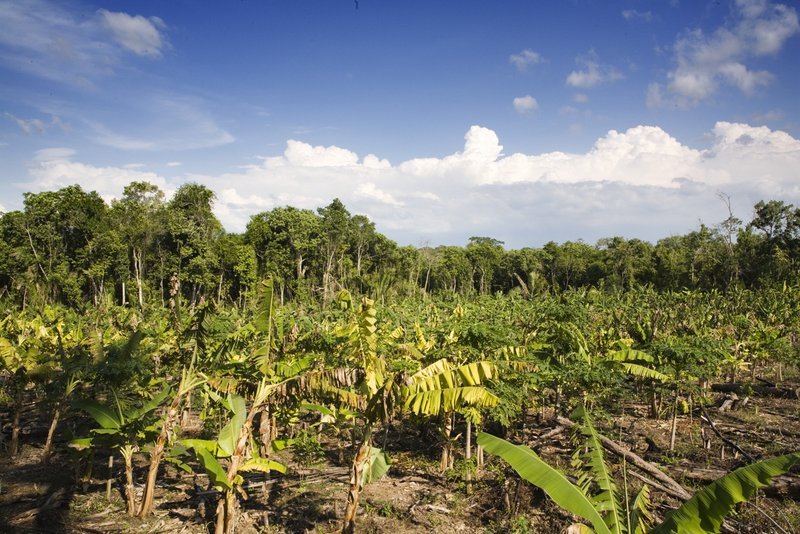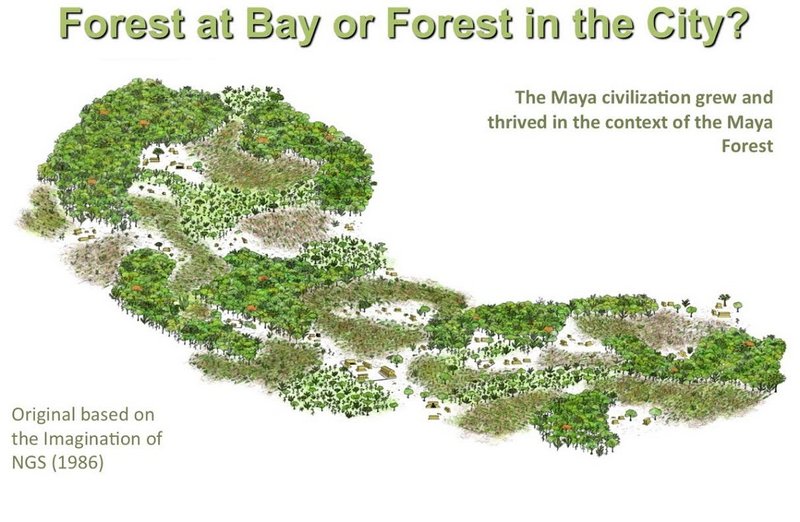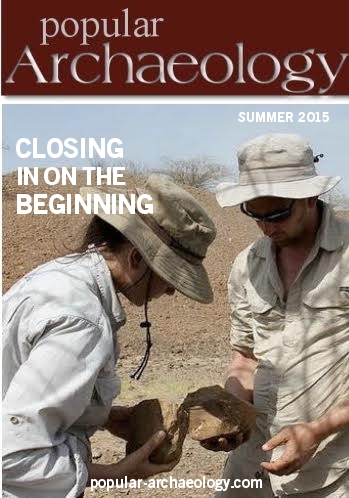 San Andres, Peten, Guatemala; polycultivated field
San Andres, Peten, Guatemala; polycultivated field For years, archaeologist Anabel Ford has been arguing the case that the ancient Maya knew well how to manage their tropical forest environment to their advantage, eventually sustaining large populations even beyond the time when many archaeologists suggest the Maya declined and abandoned their iconic Classic period pyramidal and temple constructions and monumental inscriptions during the 8th and 9th centuries CE. She challenges the popular theories long held by many scholars that the Maya declined because of overpopulation and deforestation from increased agricultural production, perhaps aggravated by draught and climate change.
“In the past there was no extensive deforestation,” states Ford.*
At the base of her reasoning stands years of research related to the ancient practice of the Maya in cultivating ‘forest gardens’, a method of sustainable agroforestry that employs an agricultural methodology called the Milpa Cycle—the creation of a polycultivated, tree-dominated, biodiverse landscape by dispersed smallholder farmers, employing natural cycles and maximizing the utility of the native flora and fauna. Having its roots even before the rise of the Preclassic Maya, it worked by sequencing an area from a closed canopy forest to an open field. When cleared, it was dominated by annual crops that transformed into a managed orchard garden, and then back to a closed canopy forest in a continuous circuit. “Contrary to European agricultural systems developed around the same period, these fields were never abandoned, even when they were forested,” says Ford. “Thus, it was a rotation of annuals with succeeding stages of forest perennials during which all phases received careful human management.”
She explains the process and its implications in detail in her new book, The Maya Forest Garden: Eight Millennia of Sustainable Cultivation of the Tropical Woodlands, co-authored with Ronald Nigh, a professor at the Centro Investigaciones y Estudios Superiores en Antropología Social (CIESAS) in Chiapas, Mexico. The book summarizes years of research evaluating archaeological, paleoenvironmental, agricultural, botanical, ecological and ethnographic and historical data from Guatemala, Mexico, and Belize, including a focus on the large Maya center of El Pilar.
“Ecological, agricultural, and botanical research on the Maya forest demonstrates that it is in fact a variegated garden dominated by plants of economic value, and thus highly dependent on human interaction,” says Ford. Thus, “the co-creation of the Maya and their forest environment was based on a strategy of resource management that resulted in a landscape called the Maya “forest garden.”
 A Maya forest garden. Courtesy BRASS/El Pilar
A Maya forest garden. Courtesy BRASS/El Pilar
 The Milpa Cycle, from maize field to perennials and back to the forest. Courtesy BRASS/El Pilar
The Milpa Cycle, from maize field to perennials and back to the forest. Courtesy BRASS/El Pilar
Moreover, Ford points to the Milpa Cycle as being responsible for producing much of the visible fabric of the ancient Maya jungle ‘backdrop’, including the Maya landscape of today—a forest that is in a real sense itself a creation and ‘monument’ of the Maya people. “The Maya forest, once thought to be a wild, pristine jungle, is, in reality, the result of prehistoric, colonial, and recent human activities,” write Ford and Nigh in their book.*
_________________________________________________________________
 Courtesy Exploring Solutons Past: The Maya Forest Alliance
Courtesy Exploring Solutons Past: The Maya Forest Alliance
________________________________________________
In other words, by managing and shaping the forest landscape elements through the Milpa Cycle into a human-sculpted environment beneficial in terms of the food, shelter, medicinal and other material needs for sustaining ever-increasing populations, the Maya became the actual creators of their tropical environment—in essence, the architects of the jungle itself. Most significantly, because of its sustainable, renewing techniques, the Milpa Cycle became a key to the longevity of the Maya civilization long after the Classic period ‘collapse’. Ford and Nigh conclude: “When political crises struck Classic Maya society, the population largely retired to the forest garden, leaving elite centers abandoned.”*
________________________________________________________________
The book, The Maya Forest Garden: Eight Millennia of Sustainable Cultivation of the Tropical Woodlands, is published by Left Coast Press and can be purchased at the Left Coast Press website.
*Ford, Anabel and Nigh, Ronald, The Maya Forest Garden: Eight Millennia of Sustainable Cultivation of the Tropical Woodlands, Left Coast Press, June 2015.
________________________________________________________________
 Read more in-depth articles about archaeology with a premium subscription to Popular Archaeology Magazine.
Read more in-depth articles about archaeology with a premium subscription to Popular Archaeology Magazine.
In addition, the latest Popular Archaeology ebook is now available.
______________________________________________
Travel and learn with Far Horizons.
____________________________________________
 Popular Archaeology’s annual Discovery Edition eBook is a selection of the best stories published in Popular Archaeology Magazine in past issues, with an emphasis on some of the most significant, groundbreaking, or fascinating discoveries in the fields of archaeology and paleoanthropology and related fields. At least some of the articles have been updated or revised specifically for the Discovery edition. We can confidently say that there is no other single issue of an archaeology-related magazine, paper print or online, that contains as much major feature article content as this one. The latest issue, volume 2, has just been released. Go to the Discovery edition page for more information.
Popular Archaeology’s annual Discovery Edition eBook is a selection of the best stories published in Popular Archaeology Magazine in past issues, with an emphasis on some of the most significant, groundbreaking, or fascinating discoveries in the fields of archaeology and paleoanthropology and related fields. At least some of the articles have been updated or revised specifically for the Discovery edition. We can confidently say that there is no other single issue of an archaeology-related magazine, paper print or online, that contains as much major feature article content as this one. The latest issue, volume 2, has just been released. Go to the Discovery edition page for more information.
____________________________________________







